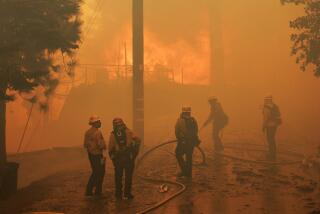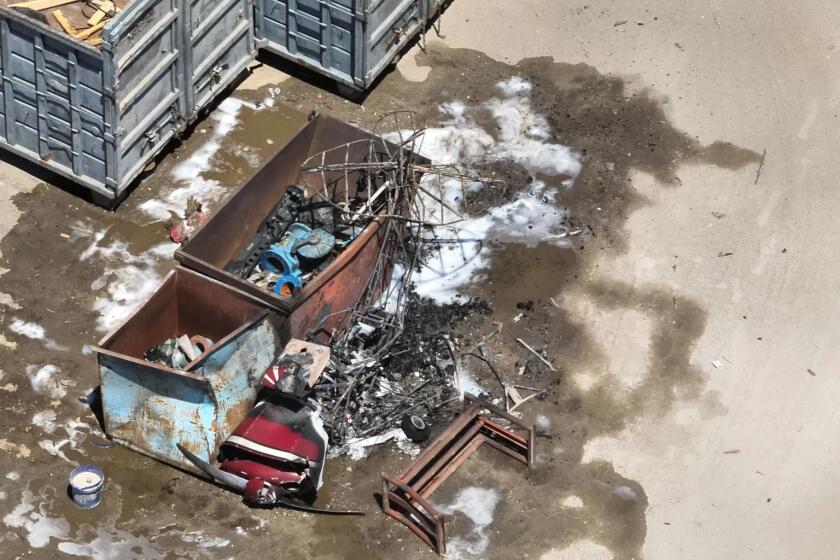Caltrans Begins $2-Million Project to Shore Up Aging Drawbridge in Harbor
Richard Luecht knows the Commodore Schuyler F. Heim drawbridge from the massive concrete pillars at its base to the huge electric motors atop twin 272-foot towers. And he says the old bridge is hurting.
From a distance, the harbor landmark appears as impressive as ever. It stands like a sentinel at the north entrance to Terminal Island.
But Luecht, a maintenance supervisor for the California Department of Transportation, shows how 40 years of jolts and thuds have taken their toll.
As huge semi-trucks whoosh by, he points to mangled sections of the steel-plate roadway. From the catwalks beneath the deck, Luecht can easily see where errant ships and barges have bashed the pilings that protect the concrete foundation.
As if the daily damage were not enough, Luecht motions to a heavy girder in one of the towers that twisted during last year’s Oct. 1 earthquake. And years of oil-pumping from the once-vast reserves beneath Terminal Island have caused the bridge, waterway and surrounding areas to sink 10 feet.
The structure, highest vertical lift bridge in the nation when it opened in 1948, has seen better days.
Now, help is on the way. Caltrans this month began a $2-million project to refurbish the aging dark-green bridge. A crew worked from a barge at the base of the bridge last week driving new wooden piles, which resemble telephone poles, into the bottom of Cerritos Channel, which connects Long Beach and Los Angeles harbors.
New steel grating--which will make passing cars sound like buzzing bees--will replace the pitted, patched roadway. The operator control room will be nearly doubled in size and modern computerized controls will allow an operator to push one button to raise and lower the 820-ton span.
The job is expected to be completed by March. The bridge will be closed to all water traffic for three months starting Nov. 28. For part of that time, it also will be closed to vehicle traffic mostly at night while the roadway is replaced.
The overhaul could not come at a better time. Luecht said port expansion is expected to increase the number of freight-hauling trucks using the bridge, which spans Cerritos Channel at the south end of the Terminal Island Freeway, California 47.
Trucks will be able to use the freeway to link up with the widened and improved Alameda Street in Wilmington, which leads to containerized freight rail yards. A fleet of trash trucks also is expected to use the bridge when the city of Long Beach opens its new Southeast Energy Resource Recovery Facility, a trash-to-energy plant, just south of the bridge.
“They’re enlarging the port so quickly we have to compensate for the extra traffic,” Luecht said.
Built at a cost of $14 million, the bridge was named in honor of the first commanding officer of the Terminal Island Naval Base, which opened during World War II. Two concrete counterweights compensate for the massiveness of the span, which is cranked up and down by a 100-horsepower electric motor in each tower. The city operated the 700-foot-long bridge until 1964, when the state took control.
Today, the lift bridge seems like an anachronism compared to such graceful spans as the Vincent Thomas and the Gerald Desmond that link the island to San Pedro and Long Beach, respectively.
50 Feet Above Water
Although many vessels can clear the bridge’s height of about 50 feet in its lowered position, the bridge is opened more than 8,500 times a year for tall-masted boats, Luecht said.
The bridge has seen occasional improvements through the years. Luecht points to a new barricade system that pops up in the bridge deck to prevent vehicles from plunging into the channel when the bridge is raised. A series of heavy vertical bars has replaced the original cable barricade.
The bridge also has an automatic alarm system that sounds a siren, illuminates a warning sign and turns blinkers from yellow to red when it senses that an approaching truck exceeds the 15-foot height limitation.
Still, Luecht said some truck drivers ignore the warnings. Flatbeds stacked with junked cars headed for the scrap-steel yards are a special problem. He said that some mornings, the bridge deck is littered with car hoods and other parts that have been knocked off.
Most of the time, though, operating the bridge is a pretty mundane task for its crew of operators who trade shifts around the clock. One of them, Marie Castle, 38, waits in the small booth for the two-way radio to crackle or a vessel’s horn to blast with a request to open the bridge.
She has a variety of signaling devices at hand. Besides the bridge’s own whistle and radio, she can wave a white flag if she can open the bridge, a red one if she cannot. By night, she has white and red lamps to signal waiting boats and ships.
If the bridge can be opened, Castle turns to an old control panel with an array of switches, knobs and dials. She sounds the sirens and closes the gates to vehicle traffic.
Then she turns a lever that starts the electric motors lifting the huge steel-grated roadway of the bridge to allow a ship or barge to pass. Then the roadway is gently lowered back in place, gradually reducing speed until it locks in place.
More to Read
Sign up for Essential California
The most important California stories and recommendations in your inbox every morning.
You may occasionally receive promotional content from the Los Angeles Times.






